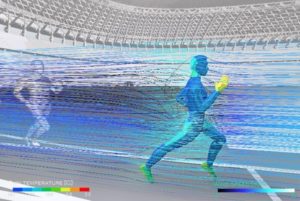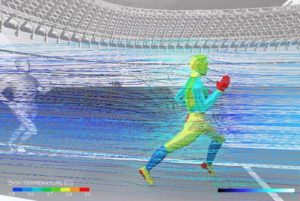
What’s the biggest challenge facing high performance athletes this year at the Tokyo games? For many, the greatest hurdle will be the record heat and humidity levels. We used computer modelling to understand and predict the situation.
The temperature in Tokyo this summer has already reached 31°C or 87.8°F and may go higher. It’s a situation that has led authorities to issue special guidance to competing athletes. In a similar way to preparing for high altitude conditions, sports teams undergo heat acclimatisation with purpose built environmental chambers or hot rooms.
Any kind of physical exertion in high temperature can lead to heatstroke, acclimatisation helps but only to a certain extent. When your core temperature rises above 39°C or 102.2°F, enzymes begin to denature and biological functions slow down or stop altogether.
Anyone suffering from heatstroke needs immediate medical attention. It’s a condition that can cause fainting, seizures and untreated it can lead to permanent damage to vital organs. This serves to highlight the importance of understanding the causes of heatstroke and how this dangerous condition might be avoided.
What causes heatstroke in athletes?
The main factors leading to heatstroke in athletes are the ambient temperature of the performance area, the percentage humidity in the air, and the actual movement of the air (which affects the ‘feels like’ temperature).
The temperature in Tokyo has already reached dangerous levels for high performance athletes. The body’s normal response to over heating is to start perspiring. The moisture on the skin evaporates and draws heat away from the body. The problem in Tokyo is the humidity. The air is already saturated, and moisture can’t evaporate so our natural way of regulating body temperature doesn’t work.
In a situation like this, any kind of intense physical exertion will put a great deal of strain on the body. The important question is, can it be measured? Can it be quantified? If so, we can make predictions and prevent injury.
How computer simulations can help
These three factors (temperature, humidity and air movements) are central to thermo-fluid analysis. That’s a branch of engineering that seeks to understand and predict heat transfer in the context of moving particles, liquid or vapour. Being able to quantify those factors, scientists can then use computer modelling to understand and perhaps mitigate the possibility of heatstroke.
With computer-aided engineering (CAE) we can make simulations that accurately model all sorts of physical phenomena. It has applications across many industrial sectors from automotive and aerospace, through to medical equipment. The discipline of simulating fluid phenomena and thermal effects is called computational fluid dynamics (CFD) and that’s how we can model conditions in the arena at the Tokyo games. We can see if people are at risk of heatstroke and more importantly, we can use that information to find a solution.
The model we used calculates the temperature of an athlete’s skin, the core temperature and the degree of perspiration. In our experiment we divide the body into 17 areas and overlay a separate model which simulates the circulatory system accounting for age, gender and body size.
Bringing these two models we recreated the 10,000 metres in the hot, humid conditions of a Tokyo summer. We focused on the longest track race in the games, but the results are relevant to all athletes, particularly those competing in high endurance activities during the hottest part of the day.
The two scenarios
To create some really useful data, we modelled the event in two contrasting scenarios. The first simulated hotter than average conditions at 32°C or 89.6°F with a humidity level of 90%. The second, average conditions, we ran at 27°C or 80.6° F and 70% humidity. Both were with negligible wind speed since the event takes place inside a stadium.
 |
 |
| Average conditions | Severe conditions |
The results provide important information for athletes, trainers, and organising bodies. Taking part in the 10,000m endurance race in average conditions, a runner’s core temperature is likely to just reach the danger zone of 39°C or 102.2°F, with the hands and feet at 37°C or 98.6°F.
The simulation for severe conditions tells a much more startling tale. In this case the competitor’s core temperature reached 39.7° or 103.46 °F, well into the danger zone. Even more worrying was the core temperature of the runner’s head which reached 39.2°C or 102.56°F, increasing the danger and severity of heatstroke dramatically. These simulations show that an increase by just a few degrees is enough to put athletes at risk.
There’s been much discussion about the decision to hold the Games in the Tokyo summer. These simulations show the extreme conditions that athletes will be competing under. Athletes are accustomed to pushing themselves to the limits. These simulations show how racing conditions impact performance as well as the risks undertaken when the human body is pushed to extremes. What’s most interesting is the small margins of change. A couple of degrees shift in temperature can have a huge impact, so it’s only a matter of time to see whether we edge over that 39°C core temperature ‘tipping point’.
For more information about the study, download the full presentation here.


Leave A Reply